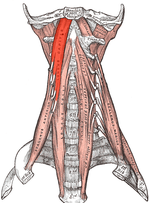Longus capitis muscle
| Longus capitis muscle |
|---|

|
| ventral neck muscles of humans (Musculus longus capitis colored red) |
| origin |
| (Tubercula anteriora of the) transverse processes of the cervical vertebrae 3 to 6 |
| approach |
| (Pars basilaris des) Os occipitale |
| function |
| Unilateral: Lateral flexion and slight rotation of the head to the ipsilateral side Bilateral: |
| Innervation |
| direct branches from the cervical plexus |
| Spinal segments |
| C2-C6 |
The musculus longus capitis , also called musculus capitis colli (from Latin musculus "muscle", longus "long"; caput "head" and collum "neck"; "long head muscle") is a striated muscle ( skeletal muscle ), which is between the sixth Cervical vertebrae and occiput runs prevertebrally (located in front of the spine). The thickness of the muscle increases from bottom to top and while it has only one attachment point on the head, it has several origins, namely the anterior tubecula of the transverse processes of the cervical vertebrae 3 to 6.
The blood supply is provided by the ascending cervical artery , vertebral artery and ascending pharyngeal artery .
function
The longus capitis muscle, which is isolated on one side , causes lateral flexion and slight rotation (turning) of the head to the same side (towards the working muscle) when it contracts ; in cooperation the two muscles lead to a ventral flexion of the head (forward bending) .
literature
- Michael Schünke , Erik Schulte , Udo Schumacher : Prometheus. Anatomy Learning Atlas. General anatomy and motor system . 4th, revised. and exp. Edition. Thieme, Stuttgart 2014, ISBN 978-3-13-139524-5 .
- Lexicon of Medicine . 5th edition. Hoffmann-La Roche ( online ).
Individual evidence
- ^ Bernhard Tillmann : Atlas of the anatomy . 2nd Edition. Springer-Verlag, 2010, ISBN 978-3-642-02680-5 , p. 567.